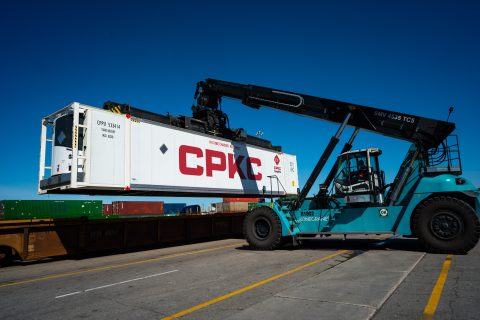Russia-India: more test shipments for Chabahar port but no investments

The port of Chabahar is again becoming a core development point for the International North-South Transport Corridor (INSTC). Russia, India and Iran plan more test shipments in the coming months that will include it. However, such plans seem vague considering that investments in the Persian Gulf port are on the low, while competition with neighbouring locations is growing.
Bilateral meetings between Iranian and Indian officials and discussions during the latest Shanghai Cooperation Organisation (SCO) summit affirmed Chabahar port’s importance within INSTC. However, this is not something new. For the INSTC to be fully operational and provide seamless connections between Russia and India, the port of Chabahar is crucial. That is because the port can accommodate large ships, while its alternative in Iran–the port of Bandar Abbas can not.
Yet, no matter how many tests are carried out, the reality is that without the needed capital flows, Chabahar will not be able to deliver the expected goals. Despite India being all in for the INSTC and recognising Chabahar’s unique position on the corridor, something seems to restrain it from investing.
Where’s the money?
Quick throwback: it must be noted that India has direct interests in the port of Chabahar. Specifically, the port is managed by India Ports Global Limited (IPGL), a state-owned Indian company. Around this time last year, IPGL announced a relatively large investment worth 25 million US dollars to equip the Shahid Behshti Terminal in the port with six new cranes. ‘Things are moving,” one could argue. However, after a reality check, it does not seem so.
The specific terminal in which IPGL invested does not seem to be in use currently, according to reports from Indian media. Furthermore, IPGL was supposed to make investments of up to 85 million US dollars in the port, so understandably, a few million dollars are missing in this case. Simultaneously, IPGL has launched tenders exceeding 91 million US dollars for the running Indian fiscal year (April 2023-April 2024), but the Indian government has only allocated 11 million US dollars for the port’s development.
Expecting only the government to invest in the port could be too much, considering that as a Free Trade Zone not subject to US sanctions, the port of Chabahar could be eligible for international investments to transform it into an international hub. Nevertheless, international investors appear hesitant.
Sanctions and regionalism an issue
Hesitation in ramping up investments in the port of Chabahar results from two factors: the first factor is sanctions. Despite the port itself being sanction free, the corridor leading to Russia and Russia itself are heavily sanctioned by the West. Consequently, many companies think twice before getting into the game because the pros of investing in Chabahar and relevant supply chains might be less than the cons. Officials from the port have noted in Indian media that there’s a need for more big Indian players to invest in Chabahar, which is now utilised mainly by medium-large Pakistani and Afghan companies “which make money and then leave.”
While Mohammad Mihiri, consultant to the President of Chabahar Free Zone, has tried to ease uncertainty concerns by stressing that sanctions are indeed an issue, but an issue that can be overcome, his appeal does not sound persuading. Sanctions are still a problem causing second thoughts to Indian but also global transport players, and they could become a reason for the port of Chabahar and INSTC generally to not reach their hype, at least as initially projected.
Apart from the business sector, India could share the same concerns on a governmental level. The rapidly growing economy is on a tightrope between the West and Russia and must carefully calculate its moves. On the one hand, it wants to keep good relations with the US and avoid getting locked in regionalised trade with Russia as its leading partner. On the other hand, opening up to the Russian economy and using the INSTC as a gateway also towards Europe is an enticing possibility. Considering all the restrictions involved, the question is whether it is a realistic possibility.
Competition in the neighbourhood
In any case, India cannot overlook a leading competitor in the region–namely China. Indian reports have been claiming that Iranian officials whisper that China is not really in favour of the Chabahar port development. See, China is investing heavily in the Pakistani port of Gwadar, which is very close to Chabahar. China has big plans for Gwadar, which will also translate into industrial investments considering that the region surrounding the port is rich in natural resources.
China is facing its own issues on the coasts of Pakistan. Nevertheless, they seem like issues possible to resolve given the right amounts of money flowing, and China will not hesitate to invest if it is in its interests.
Considering all the above, and also the fact that modern ports need to facilitate more than just cargo transhipment, Chabahar is lagging behind. Is the hype around it fading as practical and long-standing issues persist? Will it also impact the development of INSTC? One thing is for sure: the Russia-India corridor will continue making the headlines as a transport project between significant economies. However, its future is subject to decisions that could have multilayered effects and which take time to make–if ever made.




